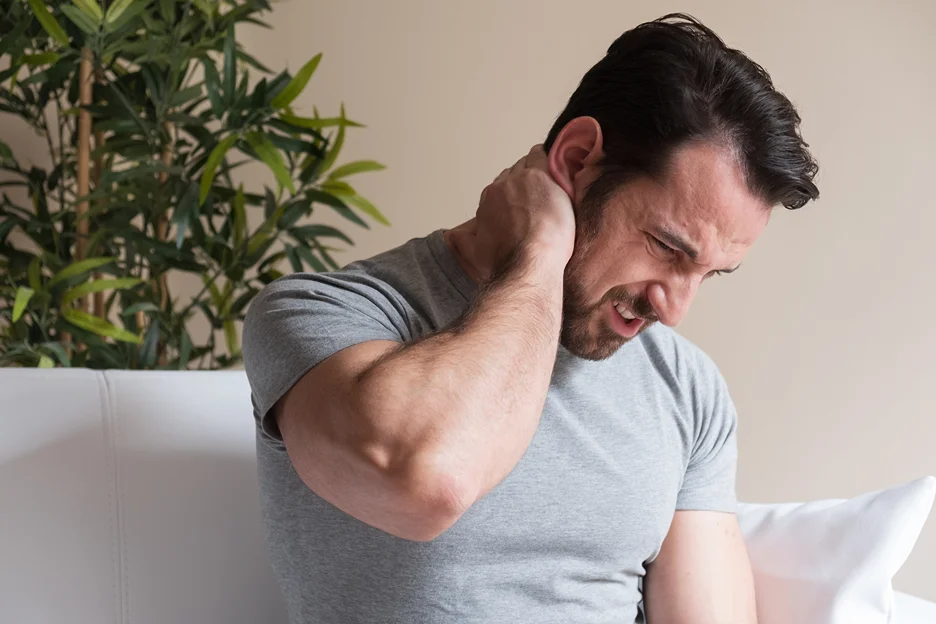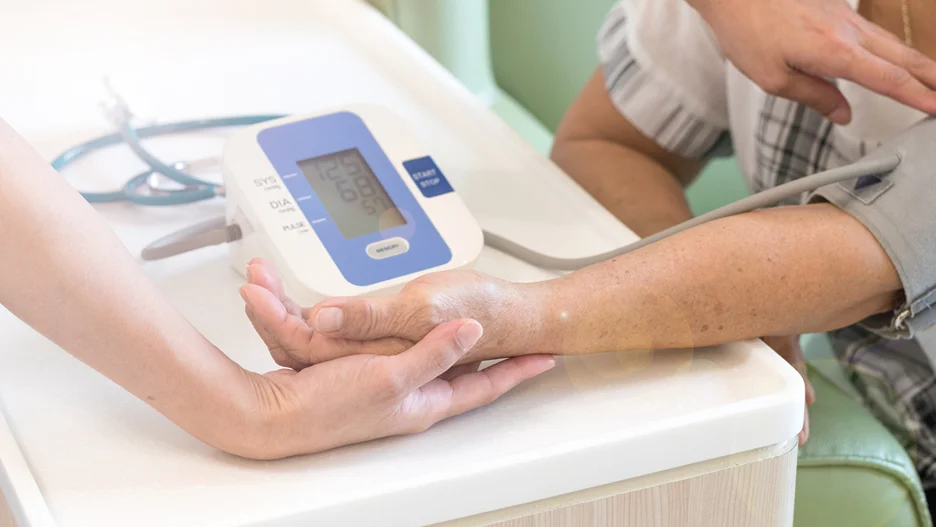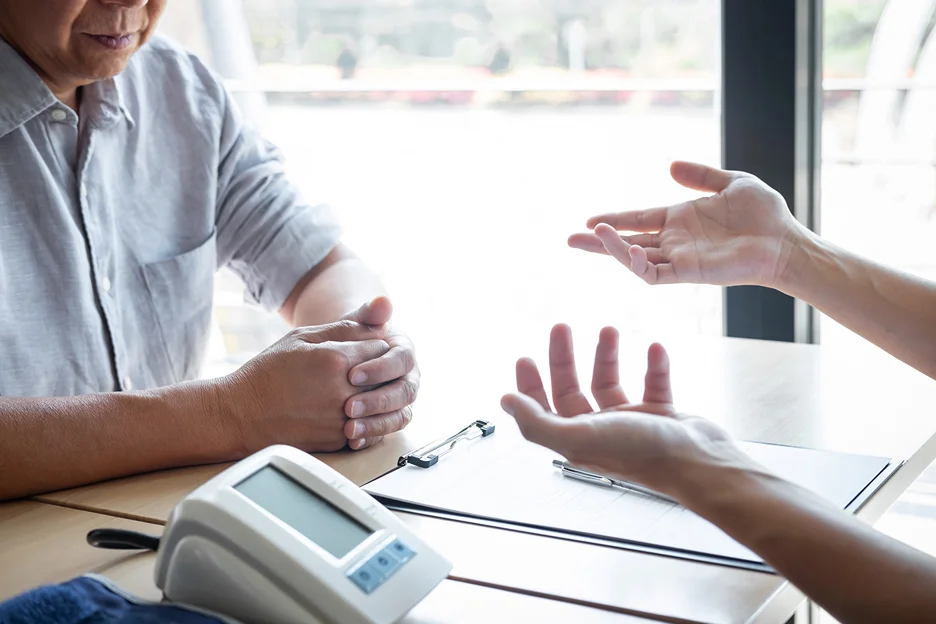Addressing the Symptom and How to Reduce Your Risk
Neck pain is one of those mundane aches that most people experience at some point. Maybe you slept in an awkward position or strained a muscle at the gym.
Typically, neck soreness resolves on its own or with some rest and over-the-counter medication. However, research shows that in some cases, sudden and severe neck pain can actually signal an impending stroke.
Understanding this connection and recognizing other symptoms that may accompany neck pain can potentially save a life by prompting rapid treatment. In this comprehensive guide, we’ll explore the link between neck pain and stroke, important signs to watch for, and ways to reduce your overall risk.
Stroke and Its Causes

First, let’s review some stroke basics. A stroke occurs when the blood supply to part of the brain is interrupted, damaging brain tissue. There are two major types:
- Ischemic stroke – Blockage of a blood vessel, often from a clot. Accounts for about 87% of strokes.
- Hemorrhagic stroke – Bleeding into the brain when a blood vessel ruptures. Makes up around 13% of strokes.
| Cause/Risk Factor | Explanation |
| High blood pressure | Damages blood vessels over time, making them more likely to become blocked and lead to stroke. Managing through medication, diet, exercise is important. |
| Smoking | Damages blood vessels and makes blood more likely to clot, blocking flow to the brain. Quitting dramatically reduces risk. |
| Diabetes | Uncontrolled diabetes damages blood vessels and makes clots more likely. Managing medication, diet, exercise helps reduce risk. |
| Obesity | Being overweight strains the circulatory system and contributes to other factors like high blood pressure. Losing weight through diet and exercise helps lower risk. |
| Lack of exercise | Being inactive leads to greater risk of high blood pressure, diabetes, obesity and blood clots. Getting regular physical activity helps lower risk. |
| High cholesterol | Causes fatty deposits to build up in blood vessels over time, making blockages more likely. Medication and dietary changes can improve levels. |
| Family history | Having a close relative who had a stroke increases your risk. Genetics can play a role in conditions like high blood pressure. |
| Age | Risk increases with age as blood vessels grow less flexible over time. People over 55 are at greater risk. |
Can Neck Pain Be a Symptom of an Impending Stroke?
Neck pain is not a classic stroke symptom like sudden numbness on one side of the body or difficulty speaking. However, research shows it can sometimes serve as an early warning sign of stroke.
One key mechanism is arterial dissection in the neck area. This involves a tear in the inner layer of an artery that supplies blood to the brain.
Dissection allows blood to enter the arterial wall, causing pain and formation of clots that can block blood flow.
Dissection of either the carotid artery or vertebral artery in the neck is a leading cause of stroke in young and middle-aged adults. Neck pain is often the first symptom.
So in some cases, acute neck pain or headache can signal the arterial dissection that leads to a stroke. Recognizing this pain and getting rapid medical treatment at the first signs allows doctors to provide clot-busting drugs or other interventions that can halt damage to the brain.
Don’t Risk It, Neck Pain May Mean Stroke – Connect with Experts via Kaly Today and Get Checked.
Are There Other Connections Between Neck Pain and Stroke?
In addition to arterial dissection, researchers have identified several other ways neck pain might be tied to stroke:
- Carotid artery disease – Plaque buildup in the carotid arteries in the neck can lead to reduced blood flow to the brain and increase stroke risk. The arteries narrowing may cause local neck pain.
- Vertebral artery – Blockages or other issues with this major neck artery that supplies the brain could result in neck pain and raise stroke risk.
- Recent neck injury – There is some evidence that neck manipulation can damage arteries. Neck pain after chiropractic work or trauma might signify this damage.
- Tension and pain after stroke – Muscle spasms and changes in posture due to weakness on one side of the body can cause neck pain in the days following a stroke.
Signs and Symptoms: How To Identify Stroke-Related Neck Pain

Sudden and severe neck pain, especially along with other signs, should prompt urgent medical evaluation. Here are clues that neck pain may be stroke-related:
- The pain comes on very suddenly, often described as the “worst headache of my life.”
- It is generally on one side of the neck.
- Other stroke symptoms are present like numbness on one side, trouble speaking, or vision issues.
- You recently had neck trauma or manipulation by a chiropractor or other provider.
- The neck is tender to touch and movement makes the pain worse.
- Headaches and neck stiffness accompany the pain.
- No recent injury or muscle strain explains the onset.
- You have stroke risk factors like high blood pressure or are overweight.
Do not try to tough out acute, severe neck pain. Call 911 or seek emergency care, especially if you also notice facial drooping, arm weakness, or speech issues. Prompt treatment could prevent long-term stroke damage.
Medical Treatments for Neck Pain After Stroke
If rehabilitation and lifestyle approaches don’t adequately control neck discomfort, a doctor may recommend:
| Treatment | Description |
| Over-the-counter pain relievers like acetaminophen or NSAIDs | Reduce inflammation. Use carefully and as directed. |
| Muscle relaxants like baclofen | Help relieve muscle spasms that can cause pain. |
| Botox injections | Temporarily paralyze muscles to reduce spasms and pain. May provide several months of relief. |
| Steroid injections like prednisone into the epidural space | Reduce swelling and irritation of spinal nerves. |
| Radiofrequency ablation | Uses heat on specific nerves to disrupt pain signals. |
| Surgery like cervical decompression | May help address structural causes of pain in some cases. |
Discuss Medications For Post-Stroke Neck Pain Today. Sign Up for Kaly and Get Connected to Experts.
How Should You Manage Pain and Headaches After a Stroke?
Many stroke survivors experience chronic neck and shoulder pain on the affected side as their muscles weaken from lack of use. Headaches are also very common after a stroke.
While pain medication can help provide relief, rehabilitation therapy is key for long-term improvement:
- Physical therapy can teach exercises to regain strength and flexibility and reduce spasms.
- Stress-reduction techniques and good sleep habits help manage pain.
- Check your posture and workspace ergonomics to prevent neck strain.
- Apply heat or ice packs to the neck for temporary relief.
- Consider medications, nerve blocks, Botox injections, or surgery if pain persists.
Controlling other stroke risk factors like high blood pressure also helps prevent further damage. Work closely with your medical providers to find an integrated pain management approach.
Physical Therapy Exercises That Relieve Post-Stroke Neck Pain
Performing certain exercises under the guidance of a physical therapist can help reduce neck pain and stiffness after a stroke. Some beneficial physical therapy exercises include:
Stretching Exercises: Gentle stretches that turn the head side to side or tilt it forward and back can increase flexibility and range of motion in the neck. This helps relieve tightness and discomfort.
Neck Strengthening: Using resistance bands or weights, exercises that target the neck muscles like the trapezius and sternocleidomastoid can strengthen them to better support the head and neck.
Posture Training: Learning proper sitting, standing and walking posture takes pressure off the neck. Posture exercises help train maintaining correct spinal alignment.
Core Strengthening: Exercises like planks that engage the deep core muscles support the neck and reduce strain placed on it.
Range of Motion Movements: Gentle neck exercises done within pain-free limits, such as shoulder rolls or chin tucks, maintain and improve mobility.
Heat/Cold Therapy: Applying hot or cold packs can soothe neck muscle pain and spasms.
Massage: Light massage performed by a physical therapist or at home helps relax tight neck muscles and improves blood flow to decrease pain.
Reducing Your Risk of Neck Pain After a Stroke
The best approach is to focus on preventing strokes in the first place. Controlling key risk factors substantially reduces your chances of having a stroke that could lead to neck pain down the road:
- Monitor your blood pressure and work to keep it below 120/80 mmHg.
- Take steps to prevent and control diabetes through diet, exercise, and medication if prescribed.
- Have your doctor check your cholesterol and triglycerides. Follow treatment recommendations.
- Reach and maintain a healthy body weight for your height.
- Eat a diet centered on vegetables, fruits, whole grains, lean protein, and healthy fats. Limit sodium, sugar, and saturated fat.
- Engage in regular cardiovascular exercise for 30+ minutes per day.
- Don’t start smoking. If you do smoke, join a smoking cessation program.
- Limit alcohol intake to 1 drink or less per day for women or 2 for men.
- Reduce stress through yoga, meditation, or other relaxation practices.
Lower Your Stroke Risk, Avoid Subsequent Neck Pain – Chat with the Experts via Kaly Today!
What Should You Expect During Medical Evaluation of Neck Pain After Stroke

If you develop neck pain following a stroke, your doctor will take your history and perform a physical exam. They will assess:
| 1 | Exact location and severity of neck/shoulder pain. Does it radiate? Is there tenderness? |
| 2 | Muscle strength and range of motion in the neck. |
| 3 | Other stroke symptoms like headache or numbness. |
| 4 | Vital signs like blood pressure. |
| 5 | How pain responds to movement, massage, or medication. |
Your physician may order imaging like an MRI to look for disc issues, soft tissue injury, or nerve compression that could cause pain. Blood work screens for potential infections or arthritis that could contribute to pain.
If arterial dissection is suspected, your doctor may order:
- CT or MR angiography to look for vessel damage.
- Ultrasound with Doppler to check carotid or vertebral artery blood flow.
- Cerebral angiogram for detailed views of the cerebral arteries.
The goal is to pinpoint any structural cause of pain that could potentially be treated with surgery, medication, or other interventions.
Your doctor will also review your medical history and risk factors. Controlling issues like high blood pressure and diabetes is key to preventing pain and further stroke damage.
Don’t Ignore Sudden Neck Pain – It Could Save Your Life
Sudden and severe neck pain should never be brushed off as a minor ache or strain. While many causes turn out to be benign, a sharp pain in the neck can sometimes serve as an early clue to a serious health issue like stroke or arterial dissection.
Paying attention to your symptoms and promptly seeking medical care if they seem unusual or severe can make all the difference.
At the first sign of suspected stroke, call 911 immediately. Rapid treatment to restore blood flow can prevent lasting brain damage and long-term complications like neck pain.
By controlling key stroke risk factors and maintaining your vascular health, you can minimize the likelihood of experiencing neck pain post-stroke. But staying vigilant about changes in your body is just as important. Listen when your neck talks – it could end up saving your life!
Get Connected with Kaly for Your Healthcare Needs

At Kaly, we make it easy to connect with top-rated doctors, therapists, and other medical experts so you can get answers for your health questions and access high-quality care. Whether you want to discuss stroke prevention, treat bothersome neck pain, or address other health concerns, we can help.
With Kaly you can:
- Get matched with a specialist for your specific condition
- Schedule virtual or in-person visits from the comfort of home
- Securely share medical records and test results
- Communicate with your care team via messaging
- Access personalized health programs and wellness tools
Don’t wait to get the care you need. Sign up for Kaly and take control of your health. Our network of knowledgeable providers is here to help you achieve your health goals.
